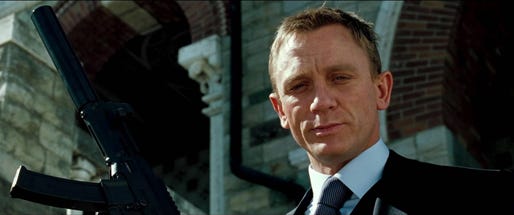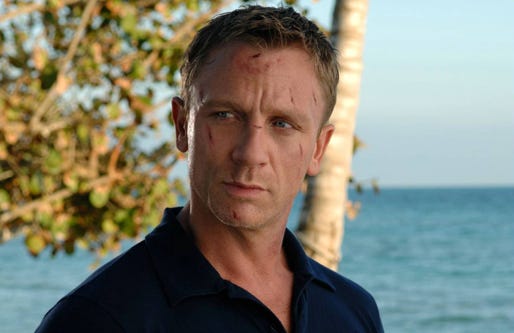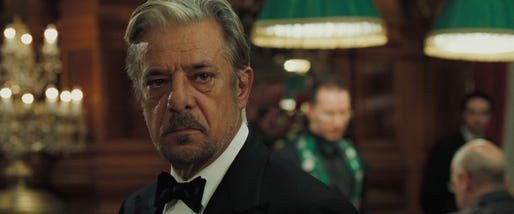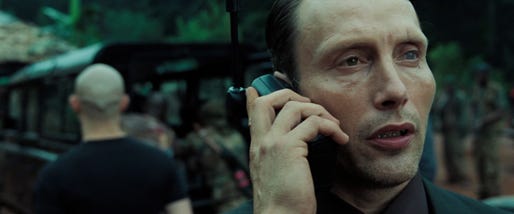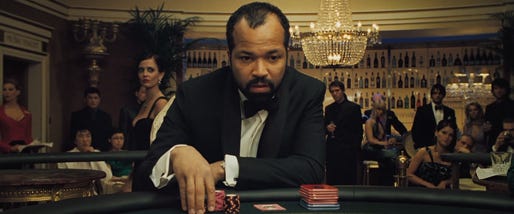You Only Live Twenty-Thrice: "Casino Royale" (2006)
“You Only Live Twenty-Thrice” is a look back at the James Bond films.
Each Friday until the release of the 23rd official Bond film, “Skyfall,” we will revisit its 22 official predecessors from start to finish, with a bonus post for the unofficial films in which James Bond also appears.
“Like all harsh, cold men, he was easily tipped over into sentiment.” — Ian Fleming, “Casino Royale,” 1953
“You do what I do long enough , there won’t be any soul left to salvage.” — James Bond, “Casino Royale,” 2006
Knuckles. Forehead. Fingers. Chest. For a man not mortally wounded, James Bond is bleeding everywhere.
Some of the blood is his. Some of it belongs to the assassin whose life he just choked out in a stairwell. Regardless, crimson cakes the rim of his whiskey decanter. It dots the starched shirt he rips open. It drips in teary rivulets from his temples. It tinctures the half-filled sink. The water meant to cleanse is, like him, stained.
He massages his face. Downs a drink. Exhales. Closes his eyes. But those nerves aren’t truly steeled. Not now. Not yet. A hitch in his breath. A slight downward bow of doubt. Then, a gaze into what is becoming an abyss — his own face in the mirror.
This is not 007’s ordinary pause for replenishment and respite. This is nothing less than a moment to reconsider the life he’s chosen. Were any modern-day face built to harden into focused, violent confidence, it’s Daniel Craig’s. But that doesn’t happen in this scene of 2006’s “Casino Royale,” which, in the matter of a moment, radically reboots the Bond films by more or less reinventing a man we’ve known for 44 years.
Yes, Bond summons the energy to return to a Montenegro poker table — where MI6 has staked him millions to defeat indebted terrorist financier Le Chiffre (Mads Mikkelsen) in hopes he’ll talk to escape violent creditors like those Bond just killed.
But has 007 summoned the resolve to continue as a bred-to-be, Double-O killer for MI6? To judge situations dispassionately and remove his ego from the equation, as M (Judi Dench) has mandated? Only in the final minutes does the film — and Craig’s measured, blistering debut Bond performance — answer these questions in the franchise-preserving affirmative.
“Royale” rubs so much salt in Bond’s wounds to counter the sugar rush of its most immediate predecessor. With both the emotion and the action sequences running raw, “Royale” is as invigorating for its intimate revelations about its characters as for its hard-charging spectacle. The result is the greatest 007 film since “From Russia with Love” — perhaps not coincidentally Craig’s favorite Bond outing.
As in “Russia,” Bond is rattled by how easily the bad guys seem to roll him — misinterpreting signals, screwing up and bleeding, a lot; Craig’s face and hands look perpetually scratched with staples.
René Mathis (Giancarlo Giannini), Bond’s aide de camp in Montenegro, is clearly modeled after “Russia’s” Ali Karim Bey — advising Bond on the power of personality while being potentially duplicitous himself.
Nearly all of “Royale’s” action scenes focus on close-quarters hand-to-hand combat, reminiscent of 007’s train grapple with Grant and the climactic evasion of Rosa Klebb’s shoe knife. But it isn’t merely cheery homage: These moments place Bond face to face with mortality and suggest his ability to expedite it in others clouds the insights he needs to save himself. Plus, “Royale” also ends in Venice, only on a note of fatal finality rather than flippant flirtation.
And to think this refreshingly uncompromising rewind almost didn’t happen thanks to another round of Hollywood hardball.
In 1997, Sony Pictures announced intentions to produce its own James Bond movie. Having remade “Thunderball” 14 years earlier, Kevin McClory was again flaunting his court-upheld rights to that title — cozying up to Sony for a project to be called “Warhead 2000 A.D.”
Often in as much financial flux as Le Chiffre, MGM/UA — studio home to the official Bond films — sued to block “Warhead.” Adding fuel to the fire, both studios had prepped Spider-Man films thanks to that property’s own rights-holder loopholes. When the dust, and the studios, settled, “Warhead” was shelved and MGM recovered the rights to “Royale” — Ian Fleming’s first James Bond novel, sold long ago to what was then Columbia Pictures and produced as a 1967 unofficial Bond spoof.
Sony’s consolation prize came in at $3.2 billion (and counting), as MGM gave up its claim to Spider-Man. And Sony eventually got its hands on Bond anyway, leading a consortium to purchase MGM in 2005 and gain distribution rights to all Bond films starting with, yes, “Royale.”
Neither was “Royale” initially intended as a reboot. In 2004, screenwriters Robert Wade and Neal Purvis started the script with Pierce Brosnan in mind — even though Brosnan had already fulfilled his four-movie contract. Quentin Tarantino expressed interest in directing, but only in black-and-white and with Brosnan. However, in February 2005, Brosnan, pushing 50, exited the role, and producers Michael G. Wilson and Barbara Broccoli spitballed some 200 names to fill it.
Goran Višnjić of “ER” made the final four but apparently couldn’t master a British accent. So did a then 22-year-old Henry Cavill — reportedly director Martin Campbell’s first choice but vetoed by Wilson and Broccoli in favor of someone older. (While Višnjić remains franchise-free, Cavill will carry Superman’s mantle in 2013.)
So, Craig it was, much to the dismay of many an Internet troll. Craig is short, blond and pugnacious, they said, not tall, dark and handsome. They overlooked his diverse character turns in “Munich” and “Road to Perdition” as well as the cool he oozed in “Layer Cake,” instead citing his only real action credit to date (the admittedly unfortunate “Lara Croft: Tomb Raider”). But this quote from Craig about his approach to Bond informs the exceptional work he’s done here and in 2008’s “Quantum of Solace” (which, essentially, plays out like an extended third act to “Royale”):
“The question I keep asking myself while playing the role is, ‘Am I the good guy or just a bad guy who works for the good side?’ Bond’s role, after all, is that of an assassin when you come down to it. I have never played a role in which someone’s dark side shouldn’t be explored. I don’t think it should be confusing by the end of the film, but during the film, you should be questioning who he is.”
Save its prologue, there’s nothing black-and-white about “Royale.” This noirish stylistic choice — a franchise first — forces the viewer to zero in on shadows, faces and uncertainty. Bond is en route to his second kill to attain Double-O status. He’s targeting a duplicitous MI6 section chief. Right away, we wonder: Is Bond truly eliminating a rotten egg or merely paving the way for another’s corruption?
We also see, in the blinding-white contrast of a flashback, Bond’s first kill — which primarily involves the drowning the section chief’s contact in a bathroom sink. (Water, as it turns out, is an evocative motif in “Royale’s” script, which Oscar-winning screenwriter Paul Haggis punched up. It metaphorically plumbs water’s properties of purification and suffocation, sometimes simultaneously.)
“Royale” continues to shatter expectations as it pushes the eye-popping pre-credits action sequence into the meat of the movie. But first, we meet Le Chiffre, who got the short end of the genetic stick: He’s a wheezing asthmatic with a vitreous left eye that weeps blood thanks to a deformed tear duct.
“Do you believe in God?,” a Ugandan warlord who will later come to kill him asks. “No, I believe in a reasonable rate of return,” replies the market manipulator who short-sells stocks in successful companies before engineering terrorist attacks to sink share prices. (In the franchise’s ballsiest moment of political realism, it’s suggested Le Chiffre profited from 9/11.)
Jump to Madagascar, where Bond pursues a bomb maker named Mollaka (Sebastién Foucan). Bond gives primal chase, a predator stalking his prey. Thinking of Mollaka as quarry, not an asset, lets him dissociate from the destruction he brings. Here, there’s none of the interaction and intimacy that will cloud the rest of his mission.
And in addition to its awesome acrobatics, the use of parkour, or free-running (of which Foucan is considered a founder) is thematically rich. Like “Royale,” parkour is about breaking rules set in stone — obliterating the boundaries of structures and surfaces and skittering into places you’re not technically supposed to go.
Cameras soar to vibrant, dangerous, precipitous heights over Bond and Mollaka’s slugfest atop a construction site — the first of many fights that look like they hurt for days. And when Mollaka seeks shelter in an embassy, we see this Bond gives no damn about diplomacy.
While M slams the “self-righteous, ass-covering prigs” in the media who latch onto Bond’s kill, she nevertheless admonishes him: “Self-awareness and arrogance rarely go hand in hand. … Any thug can kill. I need to know that I can trust you and that you know who to trust. And since you don’t know that, I need you out of my sight.”
Even more rules broken: Seemingly on vacation, Bond arrives at a Bahamian club in a … compact Ford? Fear not. He finds his way into an Aston Martin soon enough. Craig’s Bond may be infinitely more violent and vulnerable than his forebears, but this snub-nosed charisma occasionally downshifts into recognizable suavity.
In actuality, Bond is going up the chain of Mollaka's contacts. And the man from whom he takes the Aston Martin is Dimitrios, who recruited Mollaka for Le Chiffre’s latest destructive mission. To discern the target, Bond brazenly marks Dimitrios's territory — seducing his wife, Solange. But he abandons Solange in the heat of the moment to chase his latest meal: Dimitrios is headed to Miami to meet Carlos, another henchman, and bomb a prototypical plane to put $100 million in Le Chiffre’s coffers.
Because this Bond has trained himself to see everyone as bodies in various states of decomposition, it’s fitting that he offs Dimitrios at a “Body Worlds” exhibit. Given his Darwinian method of dispatching people, Bond is comfortable in dioramas of death.
And yet, he’s overeager in tailing Carlos, who makes him at the airport. What follows is one of Bond’s more seismic mid-movie thrills — a foot-and-truck chase onto the tarmac that sees a cop car caught in the wash of a roaring jet and 007 curling his face into a satisfied sneer at the trap he sets for Carlos.
Whatever gratification he gets from Carlos’s gory demise is snuffed the second he sees Solange’s body back in the Bahamas — strung up in a hammock and choked with sand. Here is Bond’s true introduction to collateral damage. He caressed and charmed this woman with intimations of intimacy that led to her death. Like the moment with the mirror, Bond’s gaze at her body is not perfunctory; Campbell and editor Stuart Baird linger long enough to suggest his cage is ever-so-slightly rattled.
M reinstates Bond to active duty, but not before microchipping him like a dog to track his whereabouts. The hunt she sends him on is one at which he’ll prove less adept: Reading those around him for bluffs and tells at Le Chiffre’s poker game, which Le Chiffre must win to cover his $100 million loss. By now, he knows Bond is an agent but lets him play anyway for the humiliation he seems certain to bring to MI6: If Bond loses, Britain’s government will have directly funded terrorism.
Accompanying Bond is Vesper Lynd (Eva Green), a Treasury agent keeping tabs on his $10 million buy-in. Women have dressed down Bond before, but few of them have flayed skin as Vesper does in their introduction. Craig and Green’s conversational chemistry is instant, antagonistic and sharp-tongued in a scene that redefines the Bond girl as much as the man in whose arms she eventually seeks solace.
The ensuing card games could have been boring flips of cards and chips, hung up on defining table talk about “blinds” and “rivers.” Instead, they depict a gutsy, psychological battle of wills between Bond and Le Chiffre — the smart way, the only way, to successfully dramatize poker.
It sets the pace for elevated emotional stakes that whip into a froth in that stairwell, where Bond fights and kills the Ugandans whose money Le Chiffre has lost. Although this scene lasts barely more than a minute, it triggers a series of explosive emotional choices to linger in Bond’s memory for however long Craig chooses to hold the role.
Vesper has never seen such a sudden eruption of brutality — a chilling reminder that there’s much more than money at stake. When Bond finds a broken wine glass and a running shower upon his return to their hotel room, it’s a tense suggestion of menace — is Vesper dead? — that yields to unfettered tenderness.
In the Roger Moore era, Vesper would have sexually caved. Here, it’s merely a chaste offering of comfort. But as Bond glances at her prostrate body in bed, pausing before continuing the mission, we know what he’s as yet hesitant to admit: He has given himself over to Vesper.
That’s not to say “Royale” becomes a chamber piece of awkward silences and longing glances. Subsequent action and suspense serve to deepen Bond’s conflicting impulses and his love for Vesper. In fact, his inner turmoil becomes so distracting that he loses it all to Le Chiffre, who dupes Bond into thinking he has a tell.
In a panic, Bond turns to the only instinct that has served him well so far. But just as he’s about to assassinate Le Chiffre, CIA agent Felix Leiter (Jeffrey Wright) stakes him $5 million to return to the game.
Neither Moneypenny nor Q can be found in “Royale,” and there are barely gadgets. The closest Bond comes is a defibrillator in his car, which comes in handy after Le Chiffre poisons his drink. And although we know he can’t possibly perish here, he barely survives … thanks only to Vesper.
Eventually, Bond gets the best revenge — going all in with a $40.5 million hand to take the tournament right out from under Le Chiffre. They’re two stags butting heads, carelessly tossing and scattering chips and plaques in the middle of the table.
In their afterglow dinner celebration, Vesper plants the suggestion of a life beyond all this death and blood. Maybe, perchance, even a life with her. “You’ve got a choice, you know,” Vesper says. “Just because you’ve done something doesn’t mean you have to keep doing it.”
But Le Chiffre’s not done with either of them: He snatches Vesper, and Bond hits the road after her — hellaciously totaling his car to avoid mowing her down where Le Chiffre has left her tied up on a winding highway.
He’s then imprisoned and subjected to a scene of torture that will make any man squirm and which exceeds “Die Another Day” in a sliver of the time. Naked and strapped to a chair with the bottom cut out, Bond huffs and puffs in diaphragmatic distress. (On a side note: It’s the first Bond film in which he’s sexually objectified more than any woman. Even under threat of violence, Craig’s chiseled physique is given full display. And then there’s this earlier tit-for-tat homage to “Dr. No.”)
Only for so long does Bond put up a bollocks-to-you front against Le Chiffre, who sets about to mashing Bond’s manhood. As he hears Vesper’s screams, you can see the cocksure confidence draining from his steely, cold eyes. And just as Bond resigns himself to death, Le Chiffre’s trail of bad debt catches up with him.
Bond is surprised to awaken alive and at a Lake Como villa, where he’s recuperating from his wounds. Believing Mathis to be the one who betrayed them both, he has the man arrested, then vouches for his virility with Vesper in an empty recovery room. Only then does Bond lay out his last card.
Vesper: Does everyone have a tell? Bond: Yes. Everyone. Everyone except you. I wonder if that’s why I love you.
It’s an ultimate leap of faith — compounded by a tendered resignation and a flight to Venice. Bond unequivocally believes that, over time, Vesper’s good will balance his karmic ledger and soothe his savagery. Finally, out of everyone he’s met, Vesper is the one person he can trust. She can’t possibly have any guile, any angle, any game.
Ah, but it only sets the stage for the Bond canon’s grandest tragedy — a death tougher to watch than Tracy’s in “On Her Majesty’s Secret Service” as the character investment runs so much deeper.
Bond learns his winnings were never deposited back to the Treasury. And from a message Vesper leaves open on her phone, he knows she’s meeting the villains above Le Chiffre with the money. (It’s not until “Solace” that we come to know them as Quantum.)
Craig perfectly captures the confusion flashing across Bond’s brain: Did Vesper leave the message open in hopes he will find and save her? Or is she pure evil, so certain she’s snowed him and screwed all suspicion out of his mind?
He follows her to a building, propped up by inflatable supports, where she’s handing over the money. Gunplay ensues, the supports pop and Bond kills Quantum’s bad guys as the building sinks, with Vesper trapped in a lift. Her last words before it plummets into the water offer no answers: “I’m sorry, James.” And then he dives after her, now as enraged as he is enamored.
In the aftermath, M informs Bond that Quantum kidnapped Vesper’s boyfriend and blackmailed her into cooperation. She was only delivering the money in exchange for Bond’s life.
Of course, M could very well be mollycoddling her most ferocious animal before placing the next bloody steak before him. In the most annihilative way possible, Bond has learned M’s lesson the hard way: Trust no one. And his terse sign-off to the phone call speaks more strongly to the whispers and screams in James Bond’s mind better than any line before it.
In “Royale,” the classic “Bond, James Bond” line is no longer a boilerplate catchphrase. It’s a captivating coda — a scene that would, two years later, lead directly into the opening of “Solace.”
And it’s as perfect a moment as any to mull over the film’s theme song. Heard casually over the stylish opening credits, Chris Cornell’s “You Know My Name” is a swaggering orchestral-rock number, fusing the Soundgarden singer’s ragged howl to a driving beat, crashing strings and intrusive brass.
But its chorus is haunting in hindsight — especially considering Bond’s eventual revenge mission in “Solace” is as much about vindicating himself as it is avenging Vesper. It’s almost as if it could be broken up into M’s advice and 007’s response:
Arm yourself because no one else here will save you. The odds will betray you and I will replace you. You can’t deny the prize. It may never fulfill you. It longs to kill you. Are you willing to die?
The coldest blood runs through my veins. You know my name.
We thought we knew 007. Indeed, we knew only his name. But by the end of this grand, bold reinvention, we also know the soul, the complexity, the now-steeled nerves, and the exciting potential in Craig’s characterization of Bond going forward.
Next week: ”Quantum of Solace”
BULLET POINTS
Blink and you’ll miss a cameo from Virgin brand impresario Richard Branson getting trapped in a security checkpoint at Miami International Airport. You couldn’t see him at all in British Airways’ in-flight version of “Casino Royale.” The longtime product-placement partner to Bond, which provided a Boeing that became the fictitious Skyfleet S570, also deleted a shot of a Branson-provided Virgin Atlantic plane.
Angelina Jolie and Charlize Theron were contenders to play Vesper Lynd, as were Cecile de France of “Haute Tension” and Audrey Tautou of “Amelie,” who instead chose “The Da Vinci Code.”
“Royale” includes the largest-ever Bond-film rig — a 90-ton apparatus inside a tank at Pinewood Studios that controlled the climactic sinking of the Venetian house. The elevator inside the tank could withstand immersion in 19 feet of water. And an exterior model built to one-third scale is the one that eventually crumbles into the canal.
Daniel Craig has now starred in the two longest Bond films — “Royale” at 144 minutes and “Skyfall” a shade shorter at 143.
Another mission, another impressive (if costly) world record — achieved when Bond swerves to miss Vesper in the road. An air-powered cannon behind the driver’s seat of an Aston Martin allowed the car to complete seven full barrel rolls for the record of vehicular barrel rolls assisted by a cannon. It proves two things: 1) Guinness will verify anything. 2) Price matters not for perfecting a Bond stunt, as one afternoon of filming destroyed three cars to the tune of $300,000.

